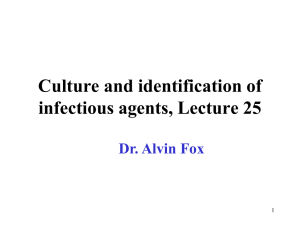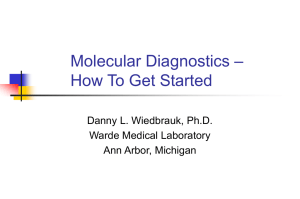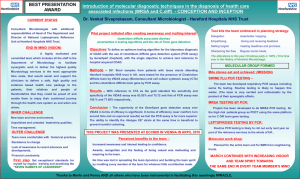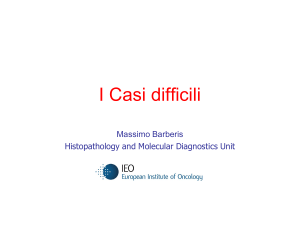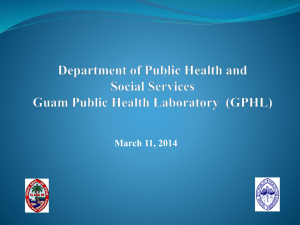When culture is
advertisement
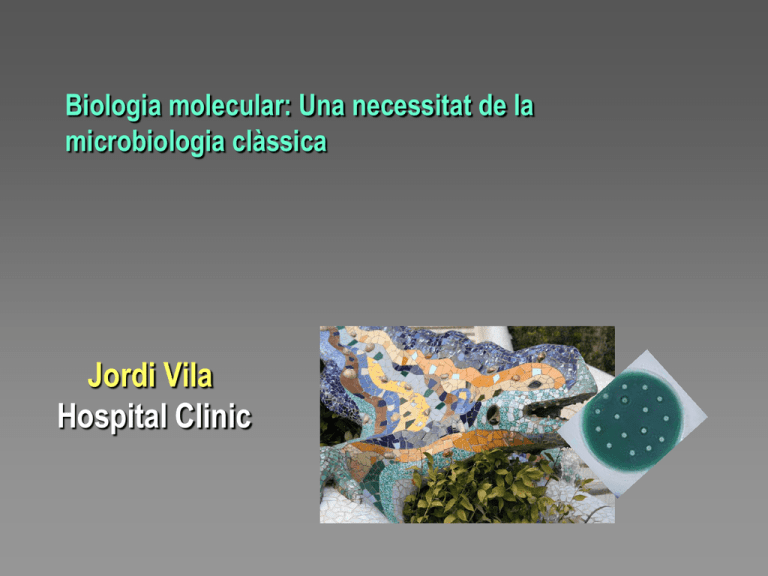
Biologia molecular: Una necessitat de la microbiologia clàssica Jordi Vila Hospital Clinic DIAGNOSTIC TECHNOLOGIES IN CLINICAL MICROBIOLOGY • • • • • Direct examination Microscopy Culture Detection of antibodies (serology) Detection of microbial antigens Detection of nucleic acids Main features for an optimal test • • • • • Detection and identification of several microorganisms related to a specific syndrome in a single test High sensitivity and specificity Rapid, in minutes better than hours Automatized Cheap Rapid diagnostic methods • Adventages – To implement adequate antimicrobial therapy – To favor the control of the emergence of antimicrobial resistance – Decrease the cost to the hospital EVOLUTION OF THESE MOLECULAR TOOLS • Hybridization of nucleic acids • DNA or RNA amplification • Real time PCR • DNA microarrays TYPES OF NUCLEIC ACID AMPLIFICATION • Target amplification system – – – – – – PCR Ligase chain reaction (LCR) Self-sustaining sequence amplification (3SR) Nucleic acid sequence-based amplification (NASBA) Transcription-mediated amplification (TMA) Strand displacement amplification (SDA) • Signal amplification system – Q-b-replicase – Branched DNA technologies (bDNA) – Cleavage-based signal amplification VARIATIONS OF THE PCR • • • • • • Multiplex PCR Nested PCR RT-PCR Broad-range PCR Real-time PCR Arbitrarily primed PCR Broad-range PCR P1 P2 16S ITS 23S 798 bp Consensus Regions Variable Regions ITS = Internal transcribed spacer 5S APPLICATIONS 0F 16S rRNA • From colony: – Bacteria with difficult phenotypic identification • Species of Acinetobacter, Corynebacterium, some anaerobes – Fastidious bacteria, due to nutritional requirements • Eikenella corrodens, Nocardia spp., etc. – Slow growth bacteria • Non-tuberculosis Mycobacteria – Bacteria with no phenotypic match with known bacteria • From clinical samples: – Previously treated with antibiotics (CSF, amniotic fluid, joint fluid, cardiac valves) • When culture is negative – Non-cultured bacteria • Rochalimae (Bartonella) quintana VARIATIONS OF THE PCR • • • • • • Multiplex PCR Nested PCR RT-PCR Broad-range PCR Real-time PCR Arbitrarily primed PCR Real time PCR (specific probes) A Probe B A Primer B Primer 3’ 5’ 3’ 5’ Molecular beacons 3’ Taq TaqMan probes A = Reporter dye B = Quenching dye A 5’ B Primer 3’ 5’ FRET Probes Real time PCR • Advantages: – Speed (1-3 hours) – Closed system decreasing the risk of contamination – Quantitation of the initial nucleic acid APPLICATIONS Detection of toxins • Detection of C. difficile toxin • Detection of PVL in S. aureus • Detection of virulence factors in diarrhoeagenic E.coli (Multiplex PCR directly from a colony identified as E.coli) – Enterotoxigenic E.coli – Enteroaggregative E.coli – Enteropathogenic E.coli APPLICATIONS Detection of specific microorganisms • Grow slowly, or for which the cultivation methods are not widely available or do not exist. – Examples: – – – – – – – Bartonella spp. Borrelia burgdorferi Ricketssias, Ehrlichia and Coxiella spp. Mycoplasma pneumoniae Chlamydophila pneumoniae Bordetella pertussis Tropheryma whipplei APPLICATIONS Detection of specific virus Detection Viral load – Parainfluenza virus 1,2,3 and 4 – HIV – Influenza virus A, B and C – HBV – Adenovirus – Respiratory syncytial virus A and B – Coronavirus – Herpes simple virus – Human papillomavirus – Enterovirus – HCV – CMV – EBV APPLICATIONS • Where reliable and rapid detection of infected or colonized patients and health care workers is used for minimizing spread of antimicrobial resistant bacteria in health care institution. Ex. MRSA • Detection of S. agalactiae in vaginal swabs. Detection and identification of several microorganisms in a single test • Respiratory infections • Gastrointestinal infections • Sexually transmited diseases infection Current alternatives to detect respiratory virus • Detection of specific microorganisms. – Virus 5’ – Parainfluenza virus 1,2,3 and 4 – Influenza virus A, B and C 5’ 5’ – Adenovirus 5’ – Respiratory syncytial virus A and B – Coronavirus N IVB ADV IVB RSV IVA RSV + ADV – Enterovirus – Metapneumovirus Nested-RT-PCR Current alternatives to detect respiratory virus • Detection of specific microorganisms. – Filmarray – Magicplex-RV (Seegene) – Abbot – Luminex – Resplex (Qiagen) – Most of them are detecting the most prevalent respiratory virus some of them can also detect atypical bacteria causing pneumonia – Overall good sensitivity and specificity Blood Classical Blood culture Gram stain Culture Semi-molecular Blood culture Gram stain Identification/Resistance ID/Antibiogram - DNA Miroarrays - Filmarray Microarrays de ADN 120 sondas para identificar: Pseudomonas aeruginosa Staphylococcus aureus Escherichia coli Genes: Housekeeping Virulencia Resistencia gen aac-aphD gen cat gen dfrS1 gen ermA gen mecA Tiempo total 8h. JCM (2006) 44:2389 Blood Classical Semi-molecular Blood culture Blood culture Gram stain Culture ID/Antibiogram Gram Stain Culture ID/Anti Identification/Resistance MS DNA Miroarrays Filmarray Matrix-assisted laser desorption/ionization mass spectrometry (MALDI-TOF MS) Acceleration Matrix-embedded Analyte on Microtitreplate Target Drift + + + + Electrodes + + Detector Laser Desorption/Ionization Time-of-Flight Intensity m/z MALDI-TOF MS Identified species Bacillus globigii BioProfiler Data interpretation Generate MALDI-TOF profile spectrum Profiling results from different Bacillus strains a.i. 6000 4000 Smear a thin-layer onto a MALDI target plate 2000 B. globigii 0 Select a colony -2000 -4000 Unknown microrganism ? -6000 B. licheniformis B. subtilis B. thuringiensis Direct testing of positive blood cultures by MALDI-TOF WHEN POSITIVE Sampling Incubation of blood culture bottles Comparison with a database Acquisition of the proteic profile Preparation of a bacterial pellet Deposition of bacterial pellet on MALDI microplate Identification of bacteria growth in blood cultures % 97 93 97 70 Juiz et al. EJCM (2011) “in press” Burckhardt and Zimmerman: Using matrix-assisted laser desoprtion ionization-time of flight mass spectrometry to detect carbapenem resistance within 1 to 2.5 hours Journal of Clinical Microbiology 2011; 49: 3321 • 10 mcl loopful of bacteria to 1 ml of 0.45% NaCl with or without 0.5 g/liter ertapenem. Incubation 2.5 h at 36ºC This methods works for strains carrying NDM-1, VIM-1, VIM-2, KPC-2 and different IMP enzymes Blood Classical Semi-molecular Blood culture Blood culture Gram stain Gram Stain Culture ID/Antibiograma Identification/Resistance MS Miroarrays de ADN Filmarray Genexpert (MRSA) Parta M et al. Identification of methicillin-resistant or methicillinsusceptible Staphylococcus aureus in blood cultures and wound swabs by GeneXpert. J Clin Microbiol 2009;47:1609 • 223 blood cultures – 68 positive to S. aureus – 47 MRSA and 21 MSSA – PCR 46/47 (98%) MRSA and 21/21 MSSA (100%) Blood Clasical Semi-molecular Blood culture Molecular Blood culture Direct detection - Septifast - Magicplex-sepsis - SeptiTest Gram Stain Culture ID/Antibiogram Gram Stain Culture ID/Anti Identification/Resistance MS Miroarrays de ADN Filmarray Genexpert (MRSA) CONCLUSIONS Advantages of these rapid tests compared to BC: - Patients receiving antibiotic - Detection of fungemia caused mainly by Aspergillus - More rapid identification than the BC. Advantages of the BC compared to these rapid tests: - Possibility to determine antimicrobial susceptibility - Detect microorganisms not included in the rapid test PCR and Mass Spectrometry (Detection of nucleic acids) • SEQUENOM – Amplification / Transcription / Cleavage / Detection of restriction fragment by MALDI-TOF • ESI Mass Spectrometry (PLEX-ID) ESI-TOF Mass Spectrometry Reflectron Q- Separation CID TOF-MS Sprayer Dry Gas Heater Glass Capillary API Spray Chamber Dual Ion Funnel Flight Tube Collision Gas Supply Hexapole Analytical Quadrupole Collision Cell Orthogonal Accelerator Detector PCR/ESI Mass Spectrometry • First, broad-range primers, targeting sites that are highly conserved in all members of a microbe family, are used to amplify PCR products from groupings of microbes rather than single species. • These primers are coupled with species- or strain-specific primers for the identification of specific pathogens or antibiotic targets. • Second, PCR conditions are, by design, permissive and thus tolerant of mismatches, so that even sequences from novel strains can be amplified. • Third, inosine and other “wild-card” nucleotides are used in primers to facilitate PCR analysis of mispaired sequences. PCR/ESI Mass Spectrometry • Fourth, because MS simply measures the mass-to-charge ratio (m/z), the sequence of the amplicon need not be known in order to detect it. The technology offers advantages over routine single-target and multiplex PCR in that it is a full bioinformatics sequence analysis system. • After amplification, MS is used to rapidly determine the precise mass-to-charge ratio for the amplified nucleic acid fragments present, and the A, C, T, and G contents (i.e., the base composition) of each amplicon are determined using proprietary software that creates a signature to allow organism identification and genotyping. • This novel MS technology enables the rapid, sensitive, cost-effective, and simultaneous detection of a wide range of typical pathogenic organisms. PCR/ESI Mass Spectrometry • Broad amplification of all microorganisms – Bacteria, virus, fungi and protozoos • Rapid detection-identification (6-8 hours) • High throughput • Able to detect co-infections • Quantitative • Detect new pathogens Next generation DNA sequencing • Full genome sequence • 1-2 weeks • All genomic information for a specific microorganism Next generation DNA sequencing • Intrahost variability of HIV or HBV – Tropism – Antiviral resistance • Compartmentalization of viral quasispecies • Viral dynamics – During natural history – After therapeutic intervention Do you think that molecular tools will fully replace conventional bacteriology? MB I DO NOT THINK SO
